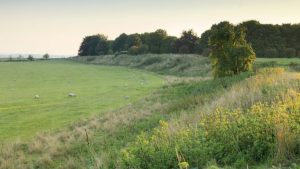Archaeologists conducting excavation at a Neolithic site at Durrington Walls discovered that the site was possibly surrounded by timber posts and not by standing stones as previously thought. The 4500-year-old site and located in the vicinity of Stonehenge. The initial assumptions were made after previous geophysical survey produced evidence for a “superhenge” of more than 100 buried stones at a site, forming a boundary.

The Durrington Walls monument, which is about 480 metres across, is just under 3km from the famous Stonehenge site in Wiltshire, United Kingdom. Ground penetrating radar revealed “anomalies” that were originally believed to be buried stones. Two of the features have now been excavated, and the stones theory has been disproved. No evidence of stones were found, but enormous pits for timber posts with ramps at the sides to lower posts into.

The pits contain timbers which have been vertically lifted out and removed at some stage. The top was then filled in with chalk rubble and then the giant henge bank was raised over the top. It was thought the giant timber monument was was put up immediately after a settlement on the site, that belonged to the builders of Stonehenge, went out of use. The timbers were taken out and an enormous bank and ditch, still visible today, were put up at the site.

(after BBC News)